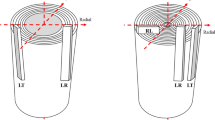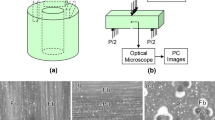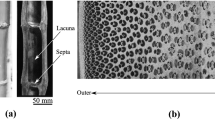Abstract
Bamboo is a unidirectional fiber-reinforced bio-composite. Once having cracks, the delaminating propagation is not controlled by the strength but by the interlaminar fracture toughness. In this paper, the behaviors of Mode I (crack opening mode) interlaminar fracture parallel to grain of moso bamboo (Phyllostachys pubescens) were studied. Based on energy theory, the Mode I interlaminar fracture toughness, G IC, was measured using the double cantilever beam specimens, and the fracture surfaces were examined under scanning electron microscope. The results show that: (1) the interlaminar fracture toughness of Mode I is the basic characteristic of bamboo material. The mean value of G IC = 358 J/m2 (coefficient of variation = 16.88%) represents the resistance arresting crack propagation. No significant difference was found for G IC among the specimens located at different heights of the bamboo. (2) Due to the low G IC of bamboo, the crack propagation parallel to grain developed easily. The crack was a self-similar fracture without fiber-bridging. On the fracture surfaces, smooth fibers and plane ground tissue were found at the extended area of Mode I fracture along the longitudinal direction. Under scanning electron microscope, it could be seen that the crack propagation developed along the longitudinal interface between fibers or ground tissue. It indicates that the longitudinal interface strength was weak among bamboo cells.






Similar content being viewed by others
References
Ahmad M, Kamke FA (2005) Analysis of Calcutta bamboo for structural composite materials: physical and mechanical properties. Wood Sci Technol 39(6):448–459
American Society of Testing Materials (ASTM) (2001) Standard test method for Mode I interlaminar fracture toughness of unidirectional fiber-reinforced polymer matrix composites. Annual book of ASTM standards. Philadelphia, PA, D 5528-01
Cook J, Gordon JE, Evans CC, Marsh DM (1964) A mechanism for the control of crack propagation in all-brittle systems. Proc R Soc 282A:508–520
Hodgkinson JM (2000) Mechanical testing of advanced fibre composites. Woodhead Publishing and CRC Press, Cambridge
Li Q, Hua XQ, Yu XW, Fu QT (2000) Development of artificial bamboo board and its research direction in China. J Zhejiang For Sci Technol 20(3):79–85 (in Chinese)
Ma LF, Ma NX (1997) Study on variation in bamboo wood properties of Phyllostachys heterocycla var. pubescens. Sci Silvae Sin 33(4):357–364 (in Chinese)
National Technical Monitoring Bureau (1995) National standard GB/T 15780–1995: testing methods for physical and mechanical properties of wood. China Standard Press, Beijing
Obataya E, Kitin P, Yamauchi H (2007) Bending characteristics of bamboo (Phyllostachys pubescens) with respect to its fiber–foam composite structure. Wood Sci Technol 41:385–400
Reiterer A, Tschegg S (2002) The influence of moisture content on the mode I fracture behaviour of sprucewood. J Mater Sci 37:4487–4491
Shen ZQ (1993) Wood science. Forest Publishing Company of China, Beijing
Triboulot P, Jodin P, Pluvinage G (1984) Validity of fracture mechanics concept applied to wood by finite element calculation. Wood Sci Technol 18(6):448–459
Yoshihara H, Ohta M (2000) Measurement of Mode II fracture toughness of wood by the end-notched flexure test. J Wood Sci 46:273–278
Yu ZC, Jiao GQ (1996) The size effects of crack in DCB test of composite materials. J Aeronaut Mater 16(4):46–53 (in Chinese)
Zeng QY, Li SH, Bao XR (1992) Effect of bamboo nodal on mechanical properties of bamboo wood. Sci Silvae Sin 28(3):247–252 (in Chinese)
Zhang QS (2003) Attaching importance to science and innovation in the processing and utilization of bamboo timber in China. J Zhejiang For Coll 20(1):1–4 (in Chinese)
Acknowledgments
The study was supported by National Natural Science Foundation of China (No. 30571452).
Author information
Authors and Affiliations
Corresponding author
Rights and permissions
About this article
Cite this article
Shao, ZP., Fang, CH. & Tian, GL. Mode I interlaminar fracture property of moso bamboo (Phyllostachys pubescens). Wood Sci Technol 43, 527–536 (2009). https://doi.org/10.1007/s00226-009-0265-2
Received:
Published:
Issue Date:
DOI: https://doi.org/10.1007/s00226-009-0265-2




